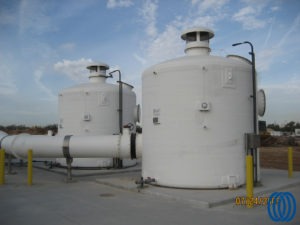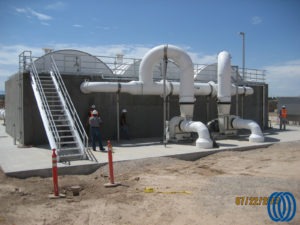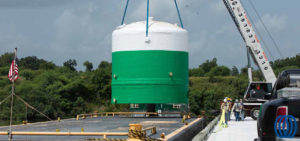 There are fiberglass boats in use today that were fabricated over 60 years ago. They have required very little maintenance during that time, and they are not yet at the end of their useful lives.
There are fiberglass boats in use today that were fabricated over 60 years ago. They have required very little maintenance during that time, and they are not yet at the end of their useful lives.
Of course, because of aggressive elements in the corrosive materials world, we cannot expect FRP corrosion equipment to have the same lifespan as FRP boats. But whenever industrial capital projects involving corrosive substances are discussed, FRP almost always comes up. Why? Because like boats in the marine environment, FRP is a very good material for pipes and tanks in corrosive environments, and often it is more cost-effective when compared to non-FRP alternatives.
To estimate the lifespan of FRP equipment, the particulars of the application have to be considered. The following is a partial list:
- Chemical aggressiveness (some concentrations of chemicals are more aggressive; impurities in the chemical can create more corrosion)
- Abrasiveness
- Flow rate
- Maximum and operating temperatures (higher temperatures tend to be more aggressive)
- Maximum and operating pressures
- Pressure and temperature operating changes
- Preventive maintenance performed on the equipment over time
In addition, the materials and methods used to fabricate FRP equipment significantly effect their lifespan. A partial list of includes the following:
- Type of resin
- Type & quantity of initiators, promoters and other chemicals added to the resin
- Type & quantity of reinforcement materials
- Laminate design
- Method of lamination
- Fiber orientation
- Void content
- Cure characteristics
While it is impossible to perfectly predict the lifespan or your FRP equipment, there usually are case histories of similar installations to examine that can provide an indication of anticipated lifespan. The supplier of the resin used in fabricating your FRP equipment may have such case histories, as well as relevant test results they can share. Also, the manufacturer of your FRP equipment may be able to suggest a time period they expect for similar applications.
The original equipment manufacturer is involved with the materials of construction, the equipment design and the quality of the fabrication. Installation, operational considerations, quality of chemicals stored (or chemical processes) and maintenance are the responsibility of the owner.
To achieve maximum product life, the manufacturer of your FRP equipment must:
- Design and engineer by FRP corrosion equipment professionals. Not only can the life span of FRP equipment be enhanced by design appropriate for the service, but manufacturing costs can be minimized, too.
- Comply completely with the specifications provided for those parts. If you need assistance creating those specs, your manufacturer may have FRP engineers on staff or work with contracted FRP specialists who can write them.
- Use quality materials only. This is not the place to skimp! Product life can be significantly reduced if substandard materials are used.
- Use manufacturing methods consistent with industry standards of high quality fiberglass fabrication. Make sure you select a manufacturer experienced in fabricating FRP equipment similar to yours. Look for manufacturers with industry certifications such as RTP-1.

To achieve maximum product life, the owner of the FRP equipment must:
- Transport FRP equipment to the job site by carriers who understand fiberglass. While FRP isn’t particularly fragile, it can be damaged more easily than steel and sometimes the damage is hard to see without careful inspection.
- Install FRP equipment by technicians who understand fiberglass. An FRP part damaged during installation will probably will have a shorter lifespan than other FRP parts in the same system. Each FRP part should be visually inspected immediately before installation.
- Consider extra ultra violet (UV) protection if installed outdoors in particularly sunny areas. A reputable FRP manufacturer should include UV protection on every part it makes, but coating the parts in a light colored gelcoat takes UV protection a step farther.
Also, while FRP is low maintenance, it is not quite no maintenance. There are certain things the owner can do to help achieve maximum life of FRP equipment in a corrosive environment:
- Don’t change or modify the service from that described in the specifications provided the FRP manufacturer. Altering the service chemical composition, temperature, pressure or turbidity can reduce the lifespan of otherwise long-lived FRP equipment. If such changes are necessary, check with the manufacturer to see if modifications are recommended.
- Inspect FRP equipment at least annually if being used in highly corrosive environments. In less corrosive environments, inspections can be scheduled less often, but in all cases, inspectors should be sufficiently knowledgeable and qualified. If repairs are needed, they can be performed before they become large and expensive.
Properly designed, manufactured and installed FRP equipment that was also used and maintained as it should will enjoy the longest lifespan. With that in mind, here are some examples:
- FRP Water tanks & pipes 30-40 years
- FRP Bleach tanks & pipes 10-15 and maybe as much as 20 years. (Built incorrectly can be as short as 1-3 years.)
- FRP Acid/Metal reaction tanks & pipes: 5-10 years or less, depending on situation
To discuss your FRP equipment in more detail, CONTACT DIAMOND FIBERGLASS.

